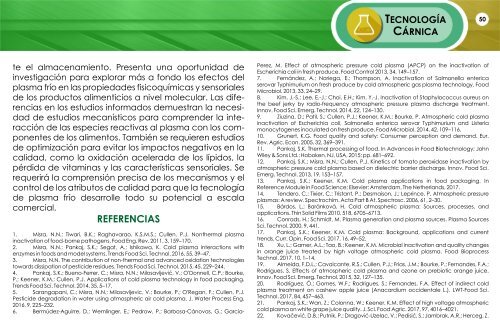ALIMENTARIA INTEGRAL FEBRERO 2018
Alimentaria Integral es una revista mensual electrónica educativa sin fines de lucro y de difusión de información tecnológica, comercial y de mercados para la industria alimentaria mexicana que se distribuye gratuitamente a los líderes de las compañías y entidades del sector.
Alimentaria Integral es una revista mensual electrónica educativa sin fines de lucro y de difusión de información tecnológica, comercial y de mercados para la industria alimentaria mexicana que se distribuye gratuitamente a los líderes de las compañías y entidades del sector.
Create successful ePaper yourself
Turn your PDF publications into a flip-book with our unique Google optimized e-Paper software.
TECNOLOGÍA<br />
CÁRNICA<br />
50<br />
te el almacenamiento. Presenta una oportunidad de<br />
investigación para explorar más a fondo los efectos del<br />
plasma frío en las propiedades fisicoquímicas y sensoriales<br />
de los productos alimenticios a nivel molecular. Las diferencias<br />
en los estudios informados demuestran la necesidad<br />
de estudios mecanísticos para comprender la interacción<br />
de las especies reactivas al plasma con los componentes<br />
de los alimentos. También se requieren estudios<br />
de optimización para evitar los impactos negativos en la<br />
calidad, como la oxidación acelerada de los lípidos, la<br />
pérdida de vitaminas y las características sensoriales. Se<br />
requerirá la comprensión precisa de los mecanismos y el<br />
control de los atributos de calidad para que la tecnología<br />
de plasma frío desarrolle todo su potencial a escala<br />
comercial.<br />
REFERENCIAS<br />
1. Misra, N.N.; Tiwari, B.K.; Raghavarao, K.S.M.S.; Cullen, P.J. Nonthermal plasma<br />
inactivation of food-borne pathogens. Food Eng. Rev. 2011, 3, 159–170.<br />
2. Misra, N.N.; Pankaj, S.K.; Segat, A.; Ishikawa, K. Cold plasma interactions with<br />
enzymes in foods and model systems. Trends Food Sci. Technol. 2016, 55, 39–47.<br />
3. Misra, N.N. The contribution of non-thermal and advanced oxidation technologies<br />
towards dissipation of pesticide residues. Trends Food Sci. Technol. 2015, 45, 229–244.<br />
4. Pankaj, S.K.; Bueno-Ferrer, C.; Misra, N.N.; Milosavljević, V.; O'Donnell, C.P.; Bourke,<br />
P.; Keener, K.M.; Cullen, P.J. Applications of cold plasma technology in food packaging.<br />
Trends Food Sci. Technol. 2014, 35, 5–17.<br />
5. Sarangapani, C.; Misra, N.N.; Milosavljevic, V.; Bourke, P.; O'Regan, F.; Cullen, P.J.<br />
Pesticide degradation in water using atmospheric air cold plasma. J. Water Process Eng.<br />
2016, 9, 225–232.<br />
6. Bermúdez-Aguirre, D.; Wemlinger, E.; Pedrow, P.; Barbosa-Cánovas, G.; Garcia-<br />
Perez, M. Effect of atmospheric pressure cold plasma (APCP) on the inactivation of<br />
Escherichia coli in fresh produce. Food Control 2013, 34, 149–157.<br />
7. Fernández, A.; Noriega, E.; Thompson, A. Inactivation of Salmonella enterica<br />
serovar Typhimurium on fresh produce by cold atmospheric gas plasma technology. Food<br />
Microbiol. 2013, 33, 24–29.<br />
8. Kim, J.-S.; Lee, E.-J.; Choi, E.H.; Kim, Y.-J. Inactivation of Staphylococcus aureus on<br />
the beef jerky by radio-frequency atmospheric pressure plasma discharge treatment.<br />
Innov. Food Sci. Emerg. Technol. 2014, 22, 124–130.<br />
9. Ziuzina, D.; Patil, S.; Cullen, P.J.; Keener, K.M.; Bourke, P. Atmospheric cold plasma<br />
inactivation of Escherichia coli, Salmonella enterica serovar Typhimurium and Listeria<br />
monocytogenes inoculated on fresh produce. Food Microbiol. 2014, 42, 109–116.<br />
10. Grunert, K.G. Food quality and safety: Consumer perception and demand. Eur.<br />
Rev. Agric. Econ. 2005, 32, 369–391.<br />
11. Pankaj, S.K. Thermal processing of food. In Advances in Food Biotechnology; John<br />
Wiley & Sons Ltd.: Hoboken, NJ, USA, 2015; pp. 681–692.<br />
12. Pankaj, S.K.; Misra, N.N.; Cullen, P.J. Kinetics of tomato peroxidase inactivation by<br />
atmospheric pressure cold plasma based on dielectric barrier discharge. Innov. Food Sci.<br />
Emerg. Technol. 2013, 19, 153–157.<br />
13. Pankaj, S.K.; Keener, K.M. Cold plasma applications in food packaging. In<br />
Reference Module in Food Science; Elsevier: Amsterdam, The Netherlands, 2017.<br />
14. Tendero, C.; Tixier, C.; Tristant, P.; Desmaison, J.; Leprince, P. Atmospheric pressure<br />
plasmas: A review. Spectrochim. Acta Part B At. Spectrosc. 2006, 61, 2–30.<br />
15. Bárdos, L.; Baránková, H. Cold atmospheric plasma: Sources, processes, and<br />
applications. Thin Solid Films 2010, 518, 6705–6713.<br />
16. Conrads, H.; Schmidt, M. Plasma generation and plasma sources. Plasma Sources<br />
Sci. Technol. 2000, 9, 441.<br />
17. Pankaj, S.K.; Keener, K.M. Cold plasma: Background, applications and current<br />
trends. Curr. Opin. Food Sci. 2017, 16, 49–52.<br />
18. Xu, L.; Garner, A.L.; Tao, B.; Keener, K.M. Microbial inactivation and quality changes<br />
in orange juice treated by high voltage atmospheric cold plasma. Food Bioprocess<br />
Technol. 2017, 10, 1–14.<br />
19. Almeida, F.D.L.; Cavalcante, R.S.; Cullen, P.J.; Frias, J.M.; Bourke, P.; Fernandes, F.A.;<br />
Rodrigues, S. Effects of atmospheric cold plasma and ozone on prebiotic orange juice.<br />
Innov. Food Sci. Emerg. Technol. 2015, 32, 127–135.<br />
20. Rodríguez, Ó.; Gomes, W.F.; Rodrigues, S.; Fernandes, F.A. Effect of indirect cold<br />
plasma treatment on cashew apple juice (Anacardium occidentale L.). LWT-Food Sci.<br />
Technol. 2017, 84, 457–463.<br />
21. Pankaj, S.K.; Wan, Z.; Colonna, W.; Keener, K.M. Effect of high voltage atmospheric<br />
cold plasma on white grape juice quality. J. Sci. Food Agric. 2017, 97, 4016–4021.<br />
22. Kovačević, D.B.; Putnik, P.; Dragović-Uzelac, V.; Pedisić, S.; Jambrak, A.R.; Herceg, Z.

















